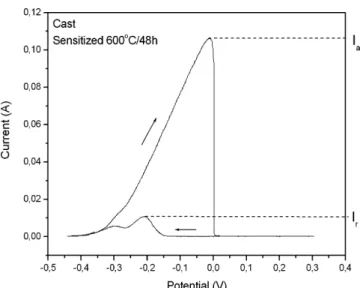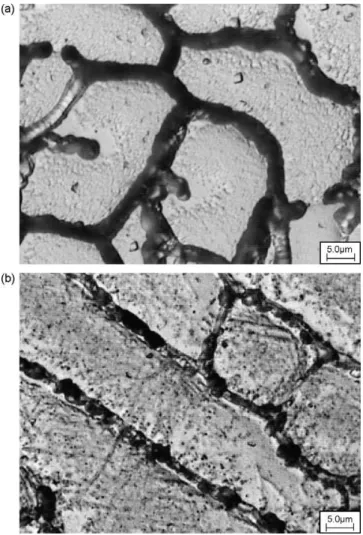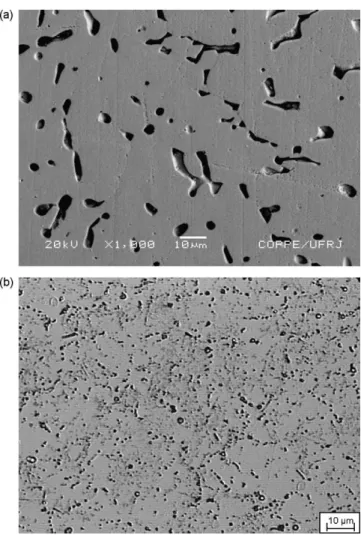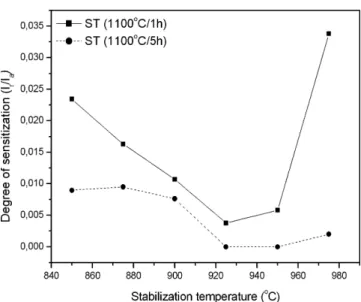j o u r n a l h o m e p a g e : w w w . e l s e v i e r . c o m / l o c a t e / j m a t p r o t e c
Influence of heat treatments on the intergranular
corrosion resistance of the AISI 347 cast and weld
metal for high temperature services
A. Yae Kina
a, V.M. Souza
a, S.S.M. Tavares
a,∗, J.A. Souza
a, H.F.G. de Abreu
baUniversidade Federal Fluminense, Departamento de Engenharia Mec ˆanica/PGMEC, Rua Passo da P ´atria 156,
CEP 24210-240 Niter ´oi, RJ, Brazil
bUniversidade Federal do Cear ´a, Departamento de Engenharia Metal ´urgica e de Materiais, Brazil
a r t i c l e
i n f o
Article history:
Received 8 April 2007 Received in revised form 3 August 2007
Accepted 8 August 2007
Keywords:
Austenitic stainless steel Stabilization
Sensitization
a b s t r a c t
Stabilized austenitic stainless steels such as AISI 347 can be selected to high temperature services due to the high creep resistance of austenite phase. Niobium is added to form fine NbC carbides, which increase the creep resistance and prevents intergranular corrosion. AISI 347 wires and electrodes are frequently used as feed metal to weld AISI 321 and 347 whrought plates. In the present work, we studied the intergranular corrosion resistance of cast structures of AISI 347 steel using electrochemical potentiodynamic reactivation tests. The study applies to cast and weld metal structures subjected to high temperature usage. The solution and stabilization treatments were evaluated. It was found that the solution treatment at 1100◦C followed by stabilization in the NbC precipitation range of temperature
is of fundamental importance to avoid sensitization.
© 2007 Elsevier B.V. All rights reserved.
1.
Introduction
Austenitic stainless steels can be selected to high tempera-ture services due to the creep properties of the fcc austenitic structure and the oxidation resistance provided by chromium. Stabilized austenitic stainless steels such as AISI 347 and 321 present other two advantages related to the Nb and Ti additions. These elements are added to form TiC and NbC carbides and stabilize the steel against sensitization in the 450◦C–850◦C range (Pickering, 1983). The fine carbides and
carbonitrides particles also increase the strength and creep resistance of the steel (Padilha et al., 2003).
In the case of the AISI 347 grade, the best corrosion resis-tance properties are achieved when all carbon of the steel is combined to niobium to form NbC. Nitrogen can also be dis-solved in this particles forming Nb(C,N) (Pickering, 1983). For
∗Corresponding author.
E-mail address:ssmtavares@terra.com.br(S.S.M. Tavares).
this reason the Nb content must be 10 times the (C + N) weight present in the alloy.
When the AISI 347 is selected to services at tempera-tures in the 450◦C–800◦C range, stabilized steels must be heat
treated to provide the maximum NbC precipitation. The kinet-ics of NbC precipitation is described by a TTT curve in which the noise is at higher temperature than the TTT diagram of chromium carbides (Padilha et al., 2003). If a solution-treated AISI 347 steel is put into service at a temperature into the sen-sitization interval (450◦C–800◦C) then Cr carbides will likely
form, since there is free carbon in solid solution. This will happen before NbC precipitation, resulting in a poor corrosion resistance. Stabilization treatment is so necessary to promote the NbC (or TiC) precipitation.
Welding of stabilized steels AISI 321 and 347 with GTAW process are often performed using AWS 347 wires. Cast
Table 1 – Chemical composition (wt%) of the AISI 347 steel studied
C 0.045
Si 0.870
Mn 1.460
S 0.012
P 0.016
Cr 19.100
Nb 0.550
Mo 0.030
Cu 0.070
Ni 9.650
ponents of AISI 347 are also used. This work is focused on the study of the influence of solution and stabilization treat-ments on the intergranular corrosion resistance of these cast structures for high temperature services (∼600◦C).
2.
Experimental
The material studied was an AWS ER 347 wire of 2.5 mm
diam-eter and chemical composition shown in Table 1. Samples
with around 7 g were melted in an arc furnace. The arc fur-nace basically is a GTAW machine where the fusion is carried out in sealed chamber with pure argon atmosphere. Solidifi-cation occurs in a water-cooled cooper crucible, after this the samples were heat treated in vacuum. The heat treatments applied were solution treatment and stabilization. Solution treatments were carried out at 1100◦C by 1 h and 5 h, followed
by water quenching. Stabilization treatments were performed at 850◦C, 875◦C, 900◦C, 925◦C, 950◦C and 975◦C by 2 h. A group
of samples were stabilized without previous solution treat-ment and another group was solution treated and stabilized. The samples were aged at 600◦C for 24 h and 48 h.Fig. 1shows
a schematic sequence of the heat treatments performed. The intergranular corrosion resistances of the samples were investigated by double-loop electrochemical
potentio-Fig. 1 – Fluxogram of preparation of samples.
Fig. 2 – DL–EPR curves of the sample cast and aged at 600◦C
for 24 h showingIrandIaobtained from the curves.
dynamic tests (DL-EPR) (Lopez et al., 1997). These tests were conducted in a conventional three-electrode cell using a Pt foil as the auxiliary electrode and a saturated calomel electrode (SCE) as the reference one. The working electrode was con-structed using the AISI 347 samples embedded in epoxy resin grinded with grid 400 emery paper, degreased with alcohol and cleaned in water. The tests were initiated when steady-state open circuit potential (Eoc) was developed (about 30 min) followed by the potential sweep in the anodic direction at 1 mV s−1until the potential of 0.3 V (vs. SCE) was reached, then the scan was reversed in the cathodic direction until theEoc. The electrolyte was 0.5 M H2SO4+ 0.01 M KSCN solution. The loss of corrosion resistance due to the chromium-depleted regions, i.e. the degree of sensitization, was evaluated from the ratioIr/Ia, whereIais the activation peak current of the anodic scan andIris the reactivation peak current in the cathodic scan, as shown inFig. 2.
The microstructures were investigated by optical and scanning electron microscopy with energy dispersive spec-trometer (EDS). Microstructures were revealed by electrolytic etch (ASTM A262-Practice A;ASTM, 1993) and Behara’s etch (20 ml of HCl, 80 ml of H2O and 0.3 g of potassium metabissul-fite).
3.
Results and discussion
Fig. 3(a) and (b) shows the microstrucuture of the as cast sam-ple containing austenite and 14.9%±3.5% of delta ferrite. The microanalysis of the delta ferrite and austenite phases (Fig. 4(a and b)) show that niobium is concentrated in the ferrite phase. A small peak of this element is observed in the ferrite phase analysis, despite of its low percentage present in the steel (0.550%).
Fig. 4 – EDS spectra of the as cast sample: (a) delta ferrite; (b) austenite.
Fig. 5 – Microstructures revealed with electrolytic etching in 10% acid oxalic solution: (a) sample sensitized at 600◦C for
24 h; (b) sample stabilized at 900◦C and sensitized at 600◦C
for 48 h.
The DL–EPR curve in the as cast condition does not show a reactivation peak (Ir/Ia= 0.0). However, if this structure is aged at 600◦C sensitization occurs, as can be seen by microscopy
(Fig. 5(a)) and also by DL-EPR test (Fig. 2).Fig. 5(b) shows the micrograph of the sample stabilized at 850◦C and aged at
600◦C for 48 h. At this condition, fine precipitates are observed
in the austenite, but there are also many holes in the austen-ite/ferrite boundaries, indicating that the material became sensitized. Indeed, the DL–EPR curves of the samples stabi-lized at 850◦C and 900◦C show pronounced reactivation peaks
(Fig. 6(a and b)). The same behavior is observed for other stabi-lization temperatures. It is interesting to note that, as general behavior, the reactivation loop is composed by two peaks. This can be attributed to some composition heterogeneities of the austenite phase in the cast structure.
Stabilization treatments become more effective when the material is previously solution treated at 1100◦C.Fig. 7
com-pares the behavior of the degree of sensitization (Ir/Iaratio) as function of the stabilization temperature with and without previous solution treatment at 1100◦C for 1 h. This
pro-Fig. 6 – DL–EPR curves: (a) sample stabilized at 850◦C and
sensitized at 600◦C for 24 h; (b) sample stabilized at 900◦C
and sensitized at 600◦C for 48 h.
Fig. 7 – Degree of sensitization (Ir/Iaratio) as function of the stabilization temperature with and without previous solution treatment at 1100◦C for 1 h.
Fig. 8 – DL–EPR curves of sample solution treated at 1100◦C
for 1 h, stabilized at 900◦C and sensitized at 600◦C for 48 h.
Fig. 10 – Degree of sensitization (Ir/Iaratio) as function of the stabilization temperature for samples previously solution treated at 1100◦C for 1 h and 5 h. The samples
were stabilized and treated at 600◦C for 24 h.
viding a better response to subsequent stabilization treat-ment.
However, the samples solution treated at 1100◦C for 1 h
and stabilized still present a small reactivation peak in the DL–EPR test (seeFig. 8, for instance). The increase of the time at 1100◦C in the solution treatment, from 1 h to 5 h, reduces the
ferrite content, as seen by comparingFig. 9(a) and (b). The delta ferrite content after the solution treatment for 5 h decreases to 6.1%±1.0%. This also leads to a better Nb redistribution, improving the response to the stabilization treatment. As con-sequence, the material shows a further decrease of the degree of sensitization, as shown inFig. 10.
Fig. 10 also shows that the stabilization temperatures which provide the lower Ir/Ia ratio are 925◦C and 950◦C. Besides of this, at these temperatures the NbC particles are relatively coarse, which is recommended to avoid re-heating cracks in this class of steel (Pickering, 1983; Younger and Baker, 1961).
The sequence of solution treatment and stabilization is sometimes of difficult application. However, this procedure
is the most indicated to avoid sensitization of welded parts and cast components during high temperature services. The sequence of solution treatment and stabilization can be car-ried out directly, just as one treatment with two temperatures steps: the material is treated at 1100◦C for 1 h or, preferentially,
5 h, and then cooled to the stabilization temperature (925◦C or
950◦C), where it is maintained by a couple of hours.
4.
Conclusions
The intergranular corrosion resistance of cast components and weld metal of AISI 347 steel is improved by solution treatment at 1100◦C followed by stabilization in 925◦C–
950◦C range. Stabilization without solution treatment results
in very poor intergranular corrosion resistance in welded and or cast components. The stabilization treatment dissolves part of the delta ferrite and redistributes the niobium in the austenite phase. The increase of the time of solution treat-ment from 1 h to 5 h promotes higher ferrite dissolution and enhances niobium redistribution, resulting in a decrease of the degree of sensitization (Ir/Iaratio) to very low values after stabilization. Solution treatment and stabilization are post-weld heat treatments specially indicated to multipass post-welds and cast components made of stabilized austenitic stain-less steels designed to high temperature services (450◦C–
800◦C).
Acknowledgements
The authors acknowledge of the Brazilian research agencies (CAPES, FAPERJ and CNPq) for financial support.
r e f e r e n c e s
ASTM A-262-93, Standard Practices for Detecting Susceptibility to Intergranular Attack in Austenitic Stainless Steels. ASTM West Conshohocken, PA, 1993.
Lopez, N., Cid, M., Puiggali, M., Azkarate, I., Pelayo, A., 1997. Mater. Sci. Eng. A 229, 123.
Padilha, A.F., Plaut, R.L., Rios, P.R., 2003. ISIJ Int. 43 (2), 135–143. Pickering, F.B., 1983. Physical Metallurgy and the Design of Steels,



